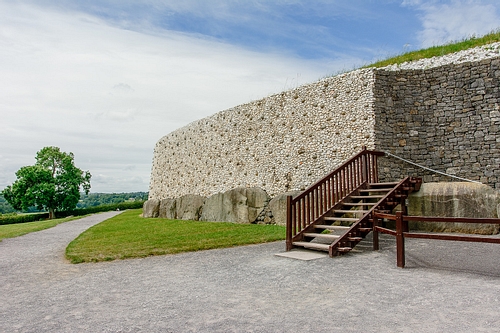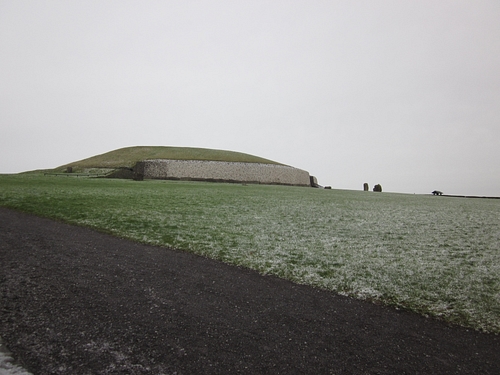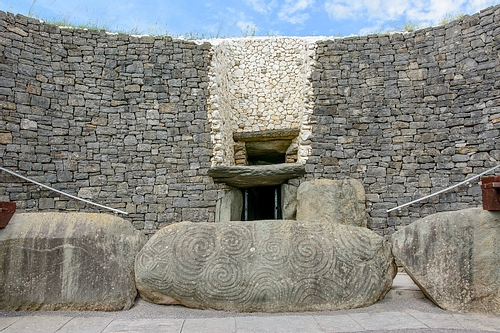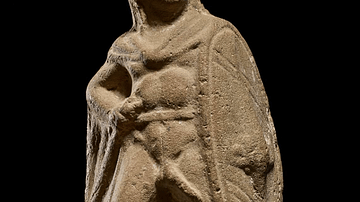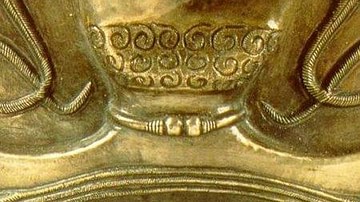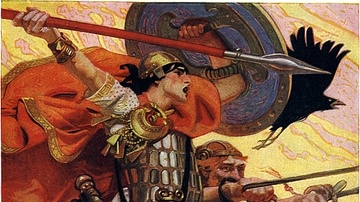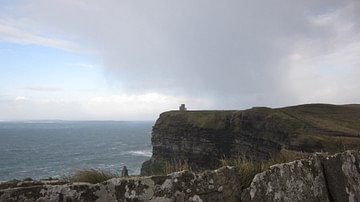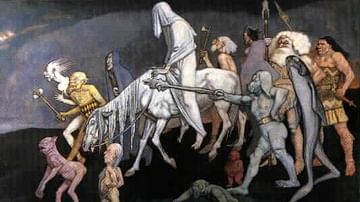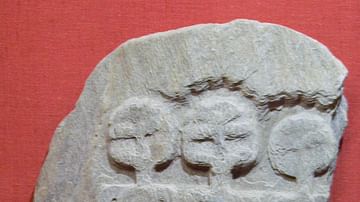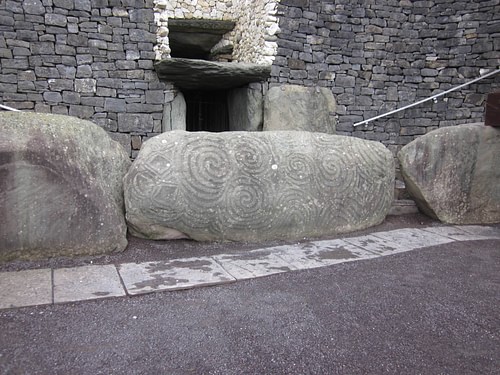
Newgrange is a Neolithic monument located in the region of Bru na Boinne, County Meath, Ireland. The name is fairly modern and comes from the 'newer' grange (farm) of the monks of Mellifont Abbey near Drogheda 8 miles (14 km) north. Although the abbey was closed in 1539 CE, the association of the land with the 'new farm' of the monks continued. Newgrange was constructed c. 3200 BCE, pre-dating the Pyramids of Giza and Stonehenge, and is part of one of the most famous and significant megalithic complexes in Europe. There are 37 tombs located in the valley of Bru na Boinne (Mansion of the Boyne), which lies at a bend in the River Boyne and includes two other enormous structures similar to Newgrange: Knowth and Dowth. The Newgrange monument is 249 feet (76 metres) across and 39 feet (12 metres) high, covering an acre of ground (4500 square metres). The entrance leads to a 62 foot (19 metres) passage, which opens to a central chamber with three recesses (sometimes also called 'chambers') in the walls at intervals corresponding to north, west, and south. Excavations have found human cremated remains in the west recess.
Although Newgrange was originally defined as a passage tomb, it has more recently been recognized as a monument whose purpose, although it included burial of the dead, was far more significant and universal. Every year, on the days around the winter solstice on 21 December, the rising sun shines through a roofbox above the entrance to illuminate the passage within and, especially, the west recess at the back of the central chamber. The archaeologist Michael J. O'Kelly was the first person in the modern age to observe this event on 21 December 1967. O'Kelly, whose work in Bru na Boinne has done the most to advance understanding of the site, is largely responsible for the re-evaluation of Newgrange as a monument rather than strictly a tomb. The monument is properly referred to as a 'cairn', a human-made mound of stones which includes water-rolled gravel. Newgrange is listed by UNESCO as a World Heritage Site.
Building Newgrange
The tombs and monuments at Bru na Boinne were built between 3300-2800 BCE. There was an older structure on the site prior to this time, which was dismantled and its stones used in the early stages of Newgrange's construction. Of the four types of megalithic tombs as defined by archaeologists - the court tomb, portal tomb, passage tomb, and wedge tomb - only passage tombs were built at Bru na Boinne. Historians George Eogan and Peigin Doyle comment on this, writing, "The builders of passage tombs represented a separate tradition to those who built portal and court tombs. This tradition developed first along the western coastline of Europe, particularly the Iberian peninsula and Brittany, before spreading to Britain and Ireland" (10). This is especially interesting because the Celts are thought to have first arrived in Ireland from the Iberian peninsula as late as 500-300 BCE, long after Newgrange was built. This has led some to argue that the Celts arrived much earlier than supposed but could also be explained by non-Celts from the same region.
A stable community must have existed in the region to have created these massive structures. They would have been skilled stone masons with considerable wealth in order to spare the time from making a living to devote to raising the great tombs and monuments. Eogan and Doyle write:
A wide range of supporting resources would be needed: timber rollers to move the huge stones . . . ropes to hold them; and boats or timber to float the stones from their source, which was often far away, to the building site. Because tombs were often built on a height, many large stones would have to be brought uphill (11).
The stones used at Newgrange were brought from as far as the Wicklow Mountains in County Wicklow - 70 miles (113.9 km) south - and the Slieve Croob Mountains in County Down - 67 miles (107 km) to the north. Stones were also brought from the Mourne Mountains, 59 miles (94 km) north of the site, while gravel was quarried locally from a pit now filled with water and referred to as the figure-eight-shaped pond. The builders would have had to locate and then move the stones from the far off mountains, most likely via the Irish Sea, and then transport them inland to Bru na Boinne. All this, obviously, would require a great deal of time and effort. Michael J. O'Kelly notes that there are 97 kerb stones, "none weighing less than a tonne, and some weighing considerably more" at Newgrange and that it contains "about 200,000 tonnes of stone" total. He writes:
None of the structural slabs were quarried, all show geologically weathered surfaces except where slabs have been deliberately pick-dressed [ornamented, as with swirls or other designs]. Their weathered condition and the striae which can be seen on some of them suggest that they were collected from where they had been left lying about at the end of the Ice Age. Imagine the difficulty of finding so many suitable slabs, half-hidden as they must have been by scrub and forest, and of bringing them onto the site, mainly uphill since Newgrange is on the top of a ridge (116-117).
O'Kelly imagines a work force divided into groups of six, some of whom carried the gravel, some hunted down the slabs, others transported them, and others set them in place. When the great monument was completed, perhaps all these or none helped in erecting the facing of brilliant white quartz, which has been restored at the monument in the present day. O'Kelly states, however, that all this is pure speculation, writing, "Let no one imagine that the foregoing is any more than a guess, made in our almost total ignorance of the life-style and habits of the builders" (118). Without a written record of any kind, there is no way of determining how the monument was built, why it was constructed, or what purpose it served. All that is certain is that the people of the area dedicated at least 30 years of their lives to building Newgrange, probably more, and that it was in almost constant use as an important ritual centre following construction.
Legend & Discovery
For some reason, the monument was abandoned during Ireland's early Iron Age (c. 3rd century BCE) following the arrival of the Celts. For the next 2,000 years there was no ritual activity in the region, and the fields were used by farmers such as the monks of Mellifont Abbey. Communal memory of the ritual importance of the site was strong, however, as evidenced in references to the monument in Irish legends and myths. The spirit folk, the Tuatha de Danaan (children of the goddess Dana), were said to have built Newgrange, and it is referred to as the tomb of either their chieftain Dagda Mor, his son Oengus of the Brugh, or the great god Lugh of the long arm, father of the hero Cú Chulain. Cú Chulainn was also thought to have been conceived at the site when Lugh visited the maiden Dechtine in a dream while she slept there. The site was imbued with magical properties and could produce food and drink (specifically ale) without end, including two pigs, one living and the other already dressed, cooked, and ready for table. In the famous Irish legend The Pursuit of Diarmuid and Grainne, Aengus brings Diarmuid's body to Bru na Boinne for burial after the hero's death and the High Kings of Ireland, crowned at Tara, were said to be buried there up until the time of the Ui Neill's (c. 800 CE).
The site was forgotten as Gaelic language, literature, and lore was suppressed, and nearly lost, under English rule. The Norman Invasion of 1169 CE brought the English to Ireland, and their control over the life of the country steadily increased in oppressive measures until it was broken by Irish patriots in the early 20th century CE leading to the establishment of the Republic of Ireland in the 1920's. Long before the English arrival, however, ritual activity at the sites slowed and then stopped, probably owing to Christian rituals replacing pagan rites following St. Patrick's missionary work in the 5th century CE.
The great mounds of Newgrange, Knowth, and Douth and the surrounding tombs were forgotten until their discovery in 1699 CE. Michael O'Kelly describes the event in his work Newgrange: Archaeology, Art and Legend:
The discovery of the 'cave' at Newgrange came about through the need for stones on the part of the then landowner, Charles Campbell. Realizing that such were to be found in plenty under the green sod of a prominent mound on his farm, he instructed his labourers to carry some away and in so doing the entrance to the tomb was discovered. This was in the year AD 1699. It was fortunate that at the same time the Welsh scholar and antiquary, Edward Lhwyd, was making a tour of Ireland and on being told of the discovery he came to Newgrange and took careful note of all that was to be seen and heard. He wrote to his friends about it and four of his letters are preserved, all giving substantially the same information. The first letter is dated 15 December 1699 and it is to be inferred that the `cave', as it was called, had been opened not too long before and that Lhwyd was able to obtain first-hand accounts of its discovery. He described what he saw in the same precise terms he was accustomed to use in his botanical and other studies (24).
Lhwyd was followed by Sir Thomas Molyneaux of the University of Dublin who made further observations that attracted still others. None of these scholars believed the monument of Newgrange had been built by the native people of Ireland, since the prevailing English attitude toward the Irish was that they were crude barbarians incapable of such a feat. Newgrange was attributed to the Vikings and even the Egyptians. Throughout the 18th century CE the site was visited by a number of antiquaries who speculated on the origin and purpose of the mound and, in the 19th, by still more including the scholar John O'Donovan and artist George Petrie, who made more educated appraisals of Newgrange. In 1882 CE the monument was taken under care of the government of the United Kingdom of Great Britain and Ireland through the Ancient Monuments Protection Act and conservation efforts were initiated.
Newgrange Today
It was not until 1962 CE that a thorough excavation of the site was begun by Michael J. O'Kelly, lasting until 1973 CE. It is O'Kelly's excavation and restoration project that resulted in the monument people visit today. In 1993 CE Newgrange was designated a World Heritage Site by UNESCO and is the best known of the many Neolithic cairns around the world (such as Maeshowe in Scotland or Gavrinis in Brittany, among others). Access to the site is through the Bru na Boinne Visitor's Centre, which offers guided tours. Over 200,000 people visit Newgrange every year from all over the world, and a lottery is held to select those who wish to participate in the sunrise observance at the winter solstice. The number of applicants (in the many thousands) attests to the enduring allure and mystery of the great monument of Newgrange.
